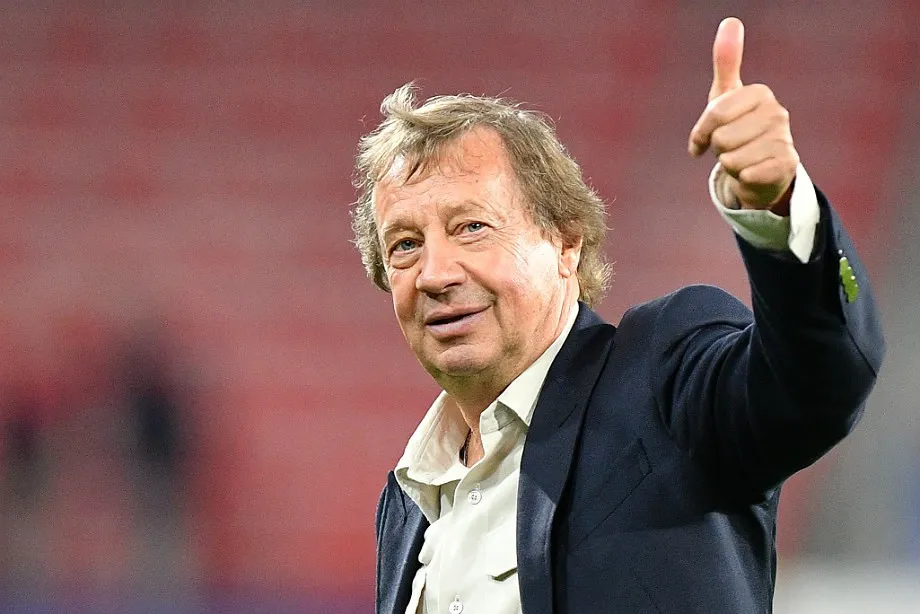Russian football has become a field of successes and dramatic moments that have gone down in history thanks to outstanding mentors. They have shaped the unique face of Russian football culture in this discipline, introduced innovations and raised generations of players. Russia’s famous football coaches have contributed significantly to the success of the national clubs, winning prestigious trophies, finishing at the top of international tournaments and strengthening the country’s position on the world stage.
The work of the mentors often remained out of the public eye, but it was these specialists who laid the foundations for the tactical mastery on which the victories of Russian teams are still based today. Their stories are rich in difficult decisions, risky tactical moves and rare but important triumphs.

Valery Gazzaev: the philosophy of victories and titles
Valery Gazzaev began his football career as a striker and played for Spartak (Ordzhonikidze), Dynamo and Lokomotiv (Moscow). His playing career ended in 1986, whereupon his coaching career began. In 1989, Gazzaev took over the management of Dynamo Moscow, where he worked on building a competitive team.
The mentor enjoyed real success at CSKA, which he took over in 2001. Gazzaev relied on a combination of experienced players and young talent. Under his leadership, the club won three Russian championships (2003, 2005, 2006), won the Russian Cup six times (2002, 2005, 2006, 2008, 2009, 2011) and reached the UEFA Cup final with a historic victory. Gazzaev has worked intensively with players such as Alan Dzagoev, Igor Akinfeev and Yuri Zhirkov, prioritising the individual development of each player.
UEFA Cup winners: a victory that made history
The match against Sporting Portugal in the 2005 UEFA Cup final was a real test for the team. The match was played in Lisbon at the Jose Alvalade Stadium, which put the CSKA players under additional pressure. The famous Russian football coach Gazzaev chose a tactic based on solid defence and fast counter-attacks. Goals from Alexei Berezutsky, Yuri Zhirkov and Vasily Berezutsky brought the long-awaited success.
This victory was an important step for Russian football and proved that the country’s teams are capable of winning prestigious European trophies. Gazzaev focussed not only on winning, but also on developing the club’s infrastructure, including training facilities and a system for training young athletes.
Yuri Syomin: architect of a locomotive dynasty
 Yuri Syomin became a symbol of Lokomotiv Moscow, which he managed from the end of the 1980s. In 1986, one of Russia’s most famous coaches began his work with the team, which in those years was overshadowed by the Moscow giants Spartak, Dinamo and CSKA. Born in Orel in 1947, Syomin had previously played for Spartak (Ordzhonikidze), Dynamo (Moscow) and Kairat (Alma-Ata). His footballing experience provided a solid foundation for a successful coaching career.
Yuri Syomin became a symbol of Lokomotiv Moscow, which he managed from the end of the 1980s. In 1986, one of Russia’s most famous coaches began his work with the team, which in those years was overshadowed by the Moscow giants Spartak, Dinamo and CSKA. Born in Orel in 1947, Syomin had previously played for Spartak (Ordzhonikidze), Dynamo (Moscow) and Kairat (Alma-Ata). His footballing experience provided a solid foundation for a successful coaching career.
A key moment in Lokomotiv’s history under Syomin’s leadership was the 2002 season, when the team won the Russian championship for the first time. This success was no accident. In the 2004 season, the club repeated this success, defeating such strong teams as CSKA and Zenit. An important role in these triumphs was played by Dmitry Loskov, who became the team’s main playmaker.
In addition, Lokomotiv achieved significant success in the Russian Cup under Syomin’s leadership, winning six trophies: 1996, 1997, 2000, 2001, 2007 and 2017. These victories have made the club one of the most coveted in national tournaments.
Strategy for success: uniqueness of approach
Syomin is known for his ability to adapt tactics to a particular opponent. In different years he used 4-3-3 and 4-2-3-1 schemes, which allowed him to find a balance between offensive and defensive actions. He devoted much attention to physical training, where he used innovative training methods to improve players’ stamina and speed.
A special place in Semin’s methodology was given to working with young players. Players such as Dmitriy Sychev, Marat Izmailov and Alexander Samedov developed under his guidance. The mentor was also characterised by his ability to create a microclimate in the team that ensured a high level of motivation among the players. Semin’s contribution as one of the most famous Russian football coaches remains a benchmark for many modern professionals.
Leonid Slutsky: Pragmatist and innovator
Leonid Slutsky, born in Volgograd in 1971, became one of the most innovative coaches of his time. His footballing career began at the Olimpia youth school, but an early injury ended his playing career. However, this did not stop Slutsky from devoting himself fully to coaching.
His work with the Russian national team began in 2015, when the team found itself in a crisis situation. Slutsky was in charge during the qualifiers for Euro 2016, and under his leadership the team won important victories against Sweden and Montenegro to secure their place at the tournament. The main stars of this team were Artyom Dzyuba and Igor Akinfeev, whose play reflected the coach’s tactical ideas.
Reforming the tactics of a famous Russian football coach: What Slutsky is remembered for at ZSKA
Slutsky’s coaching career at ZSKA began in 2009 and became one of the most successful periods of his work. Under his leadership, the team became Russian champions three times (2013, 2014, 2016) and won the Russian Cup twice (2011, 2013).
Slutsky used 4-2-3-1 and 3-5-2 schemes, which allowed the team to adapt to different styles of play from opponents. Viktor Goncharenko (assistant coach) and analytical tools, which were actively used to prepare for matches, played a major role in the successes. Slutsky’s contribution as one of Russia’s most renowned football coaches reflects his commitment to innovation and continuous improvement.
Conclusion
 Gazzayev, Syomin and Slutsky are prime examples of how a talented coach can dramatically change the face of a football team. Winning national championships, success at international tournaments and influencing the development of young athletes have made them significant figures in the history of the sport. Famous Russian football coaches continue to inspire a new generation of specialists with their professionalism, strategic thinking and unique approach to preparing teams.
Gazzayev, Syomin and Slutsky are prime examples of how a talented coach can dramatically change the face of a football team. Winning national championships, success at international tournaments and influencing the development of young athletes have made them significant figures in the history of the sport. Famous Russian football coaches continue to inspire a new generation of specialists with their professionalism, strategic thinking and unique approach to preparing teams.

Their achievements are not only part of history, but also an important element in the development of Russian football. These mentors have proven that perseverance, discipline and an analytical approach can turn any team into a winner capable of competing at the highest level.
 en
en  de
de  ar
ar  es
es  nl
nl  hi
hi  fr
fr  it
it  pt
pt  el
el 










